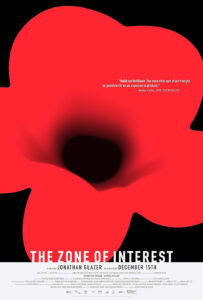 By Steve Crum
By Steve Crum
Days after watching The Zone of Interest, one is affected by the thought of spending an hour and 42 minutes with the most depraved, lost souls who ever existed. It is a harrowing experience realized through a brilliant motion picture.
A huge accolade goes to Jonathan Glazer, who directed and wrote The Zone of Interest, based upon the Martin Amis book of the same name. The title references a designated killing center (ie concentration camp) among various European locations mapped out by Nazis during WWII.
The historical drama is told in German with English subtitles. To add even more authenticity, it was filmed primarily around the infamous Auschwitz 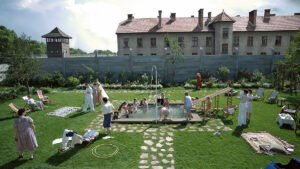 concentration camp in Poland, where more than 900 thousand mainly Jewish civilian prisoners were tortured and massacred during WWII. Shockingly, Auschwitz was but one of over a thousand “zones of interest.”
concentration camp in Poland, where more than 900 thousand mainly Jewish civilian prisoners were tortured and massacred during WWII. Shockingly, Auschwitz was but one of over a thousand “zones of interest.”
Glazer’s film focuses on the site run by Commandant Rudolf Höss, played by Christian Friedel. Moreover, it is the saga of him, his wife and family, whose house and manicured property neighbors the adjoining tall prison wall. How convenient.
The slice of life story, via the adept lens of cinematographer Lukasz Żal, is told from the point of view of Höss family members. By that I 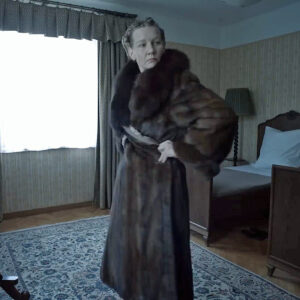 mean the focus is almost entirely upon the husband, wife, kids, and visiting friends. (And there is also a brief visit from wife Hedwig’s mother.) The “friends” are fellow Nazi officers and their families. Early on, Hedwig (Sandra Húller) models with braggadocio a full length ermine coat she has just received. We assume the coat has been taken from one of the new Jewish inmates. If that isn’t sickening enough, she later uses a tube of lipstick, procured from an inmate—without any sign of emotion whatsoever. It’s just another day of surprise gifts for her. She even dumps a load of shirts, pants and skirts on one of her kids’ beds, telling them to grab their choices! And they dive in without hesitation. Hey, it’s their way of life—made possible through death.
mean the focus is almost entirely upon the husband, wife, kids, and visiting friends. (And there is also a brief visit from wife Hedwig’s mother.) The “friends” are fellow Nazi officers and their families. Early on, Hedwig (Sandra Húller) models with braggadocio a full length ermine coat she has just received. We assume the coat has been taken from one of the new Jewish inmates. If that isn’t sickening enough, she later uses a tube of lipstick, procured from an inmate—without any sign of emotion whatsoever. It’s just another day of surprise gifts for her. She even dumps a load of shirts, pants and skirts on one of her kids’ beds, telling them to grab their choices! And they dive in without hesitation. Hey, it’s their way of life—made possible through death.
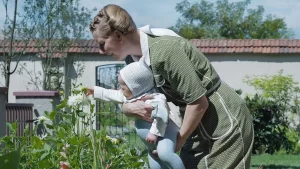 Zone is filmed in near documentary technique reminiscent of the cinéma vérité style of seemingly hidden camera, non-narrated. There is no speaking to the camera. Using that technique, we observe family members watering and trimming plants in the nicely kept garden near the house. There’s an obviously dressed inmate delivering wrapped clothing from the camp next door. The family goes swimming at a nearby lake wherein a corpse floats nearby.
Zone is filmed in near documentary technique reminiscent of the cinéma vérité style of seemingly hidden camera, non-narrated. There is no speaking to the camera. Using that technique, we observe family members watering and trimming plants in the nicely kept garden near the house. There’s an obviously dressed inmate delivering wrapped clothing from the camp next door. The family goes swimming at a nearby lake wherein a corpse floats nearby.
Then there are those surreal scenes of dad Rudolf reading a literally grim fairy tale (Hansel and Gretel) to his daughter at bedtime.
While no images of life inside Auschwitz are shown, we do see its chimney smoking. There is no graphic violence, but there are certainly threats of such. And throughout the film, periodic 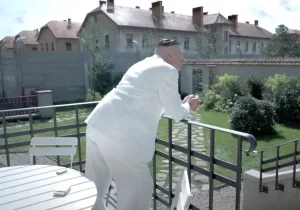 sounds of distant gunfire, babies crying, and adults screaming are heard. At other times, the chirping of birds is heard.
sounds of distant gunfire, babies crying, and adults screaming are heard. At other times, the chirping of birds is heard.
At one point, Rudolf is reassigned to another station. This creates stress on his family since they have to move. They do not want to leave their idyllic life. (Interestingly, the Höss house is still standing. Due to its noticeable age, however, a duplicate was built nearby for filming.)
Noteworthy is Mica Levi’s guttural music tones, heard at the opening and closing.
As The Zone of Interest reaches its powerful conclusion, we are left with such blatant, sad irony.
—————
GRADE on an A-F Scale: A
